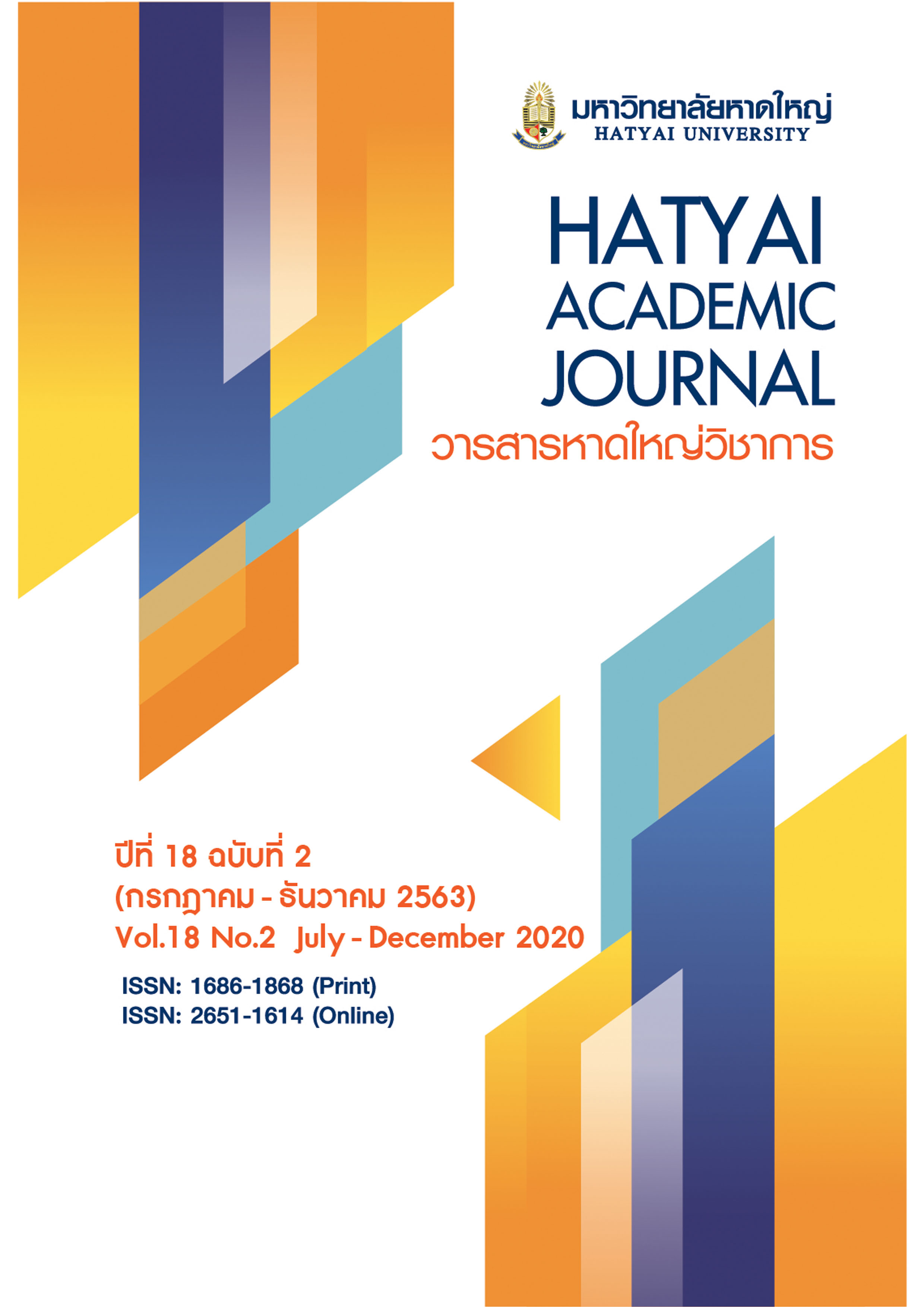A Study of Mediating Effects of ERP Adoption on the Relationship between Technological Context and the Organizational Performance
Main Article Content
Abstract
The purpose of this study was to observe the mediating role of ERP adoption on the relationship between two latent variables, technological context, and organizational performance. The study compared the models with and without the presence of the mediator, emphasizing on the empirical data collected from 285 manufacturing industries in Thailand. The results suggested that ERP adoption had mediated the relationship between technological context and organizational performance with a positive impact on organizational performance. The research implied that ERP adoption had a crucial role in organizational performance.
Article Details
All published articles are evaluated by three qualified peer reviewers from various institutions through a double-blind process, where reviewers do not know the authors’ identities and authors do not know the reviewers’ identities. The content and articles in the Hatyai Academic Journal reflect the authors’ views only and are neither the opinions of the editorial board nor the responsibility of Hatyai University. The Editorial Board of the Hatyai Academic Journal allows articles to be reproduced for academic purposes, on the condition that the original source is clearly cited.
References
Addo-Tenkorang, R., & Helo, P. (2011). Enterprise resource planning (ERP): A review literature report. In the World Congress on Engineering and Computer Science. WCECS, San Francisco, USA.
Amalnick, M. S., Ansarinejad, A., Nargesi, S.-M., & Taheri, S. (2011). New perspective to ERP critical success factors: Priorities and causal relations under fuzzy environment. The Journal of Mathematics and Computer Science, 2(1), 160-170.
Barney, J. (1991). Firm resources and sustained competitive advantage. Journal of management, 17(1), 99-120.
Bentler, P. M., & Chou, C.-P. (1987). Practical issues in structural modeling. Sociological Methods & Research, 16(1), 78-117.
Byrne, B. M. (1994). Structural equation modeling with EQS and EQS/Windows: Basic concepts, applications, and programming. USA: Sage.
Carlton, R. (2017). Ten ERP failure statistics. Retrieved from https://www.erpfocus.com/ten-erp-failure-statistics.html
Collins, P. D., Hage, J., & Hull, F. M. (1988). Organizational and technological predictors of change in automaticity. Academy of Management Journal, 31(3), 512-543.
Fornell, C., & Larcker, D. F. (1981). Structural equation models with unobservable variables and measurement error: Algebra and statistics. Michigan: University of Michigan Press.
Gavrea, C., Ilies, L., & Stegerean, R. (2011). Determinants of organizational performance: The case of Romania. Management & Marketing, 6(2), 285-300.
George, D., & Mallery, P. (2003). Reliability test, SPSS for Windows step by step: A Simple Guide and Reference (4th ed.). Boston, MA: Allyn & Bacon.
Gupta, S., Qian, Xi., Bhushan, B., & Luo, Z. (2018). Role of cloud ERP and big data on firm performance: A dynamic capability view theory perspective. Management Decision, 57(8), 1857-1882.
Hair, J. F., Anderson, R. E., Babin, B. J., & Black, W. C. (2010). Multivariate data analysis, a global perspective. New Jersey: Pearson Education.
Handoko, B. L., Aryanto, R., & So, I. G. (2015). The impact of enterprise resources system and supply chain practices on competitive advantage and firm performance: Case of Indonesian coMikumpanies. Procedia Computer Science, 72(1), 122-128.
Kharuddin, S., Foong, S.-Y., & Senik, R. (2015). Effects of decision rationality on ERP adoption extensiveness and organizational performance. Journal of Enterprise Information Management, 28(5), 658-679.
Kitrangsikul, N., & Kuntonbutr, C. (2017). The study of mediating effect of supply management capabilities on the relationship between information capabilities management and the organizational performance. International Journal of Applied Computer Technology and Information Systems, 7(1), 23-28.
Le, M. D., & Han, K. S. (2016). Understanding the impact of ERP system implementation on firm performance-focused on Vietnamese SMEs. Inter. J. Softw. Eng. Appl, 10(9), 87-104.
Liang, H., Saraf, N., Hu, Q., & Xue, Y. (2007). Assimilation of enterprise systems: The effect of institutional pressures and the mediating role of top management. MIS quarterly, 31(1), 59-87.
Lin, C.-S., & Huang, C.-P. (2011). Measuring competitive advantage with an asset-light valuation model. African Journal of Business Management, 5(13), 5100-5108.
Markus, M. L., & Tanis, C. (2000). The enterprise systems experience-from adoption to success. In W. Z. Robert (Ed.), Framing the domains of IT management projecting the future (pp. 173-207). Ohio: Pinnaflex Educational Resources.
Mata, F. J., Fuerst, W. L., & Barney, J. B. (1995). Information technology and sustained competitive advantage: A resource-based analysis. MIS quarterly, 19(4), 487-505.
Melville, N., Kramer, K., & Gurbaxani, V. (2004). Information technology and organizational performance: An integrative model of IT business value. MIS quarterly, 28(2), 283-322.
Moohebat, M. R., Jazi, M. D., & Asemi, A. (2011). Evaluation of the ERP implementation at Esfahan steel company based on five critical success factors: A case study. International Journal of Business and Management, 6(5), 236-250.
Nandi, M. L., & Kumar, A. (2016). Centralization and the success of ERP implementation. Journal of Enterprise Information Management, 29(5), 728-750.
Pan, M.-J., & Jang, W.-Y. (2008). Determinants of the adoption of enterprise resource planning within the technology-organization-environment framework: Taiwan’s communications industry. Journal of Computer information systems, 48(3), 94-102.
Parker, C. M., & Castleman, T. (2009). Small firm e-business adoption: A critical analysis of theory. Journal of Enterprise Information Management, 22(1/2), 167-182.
Preacher, K. J., & Hayes, A. F. (2008). Assessing mediation in communication research. In K. Sarah (Ed.), The Sage sourcebook of advanced data analysis methods for communication research (pp. 13-54). California: Sage.
Schniederjans, D., & Yadav, S. (2013). Successful ERP implementation: An integrative model. Business Process Management Journal, 19(2), 364-398.
Tornatzky, L. G., Fleischer, M., & Chakrabarti, A. (1990). The processes of technological innovation. New York: Lexington Books.
Tushman, M. L., & Anderson, P. (1986). Technological discontinuities and organizational environments. Administrative Science Quarterly, 31(3), 439-465.
Vanichbuncha, K. (2000). Multivariate analysis: SPSS for Windows. Bangkok: Chulalongkorn University Press. [in Thai]
Xu, W., Ou, P., & Fan, W. (2017). Antecedents of ERP assimilation and its impact on ERP value: A TOE-based model and empirical test. Information Systems Frontiers, 19(1), 13-30.

